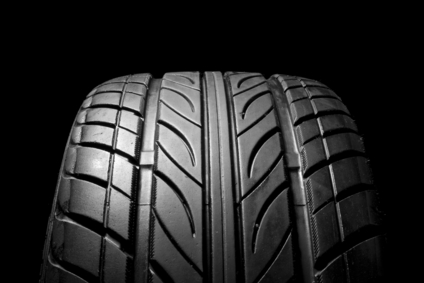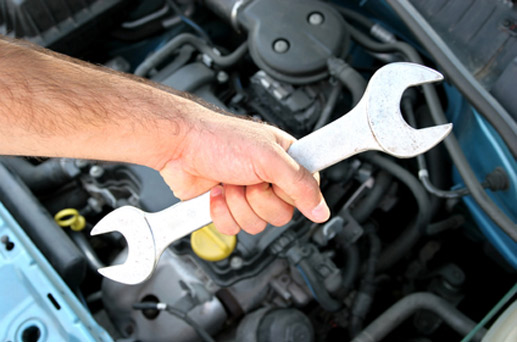Englewood Auto Maintenance Tips
Tire Maintenance Tips

PRESSURE
It’s important to have the proper inflation pressure in your tires, as under-inflation can lead to tire failure. The “right amount” of inflation for your tires is specified by the vehicle manufacturer and is shown on either the vehicle door edge, door post, glove box door or fuel door. It is also listed in the vehicle owner’s manual.
Look for this information in your vehicle:
- Check inflation pressure at least once a month and before long trips.
- Check tires when cool. After driving, tires need at least 3 hours to cool.
- Remember to check the spare.
- Visually inspect the tires to make sure there are no nails or other objects embedded that could poke a hole in the tire and cause an air leak. Check the sidewalls to make sure there are no gouges, cuts, bulges or other irregularities.
- Tire inflation pressure increases (in warm weather) or decreases (in cold weather) by 1-2 pounds for every 10 degrees of temperature change.
ALIGNMENT
Misalignment of wheels in the front or rear can cause uneven and rapid tread wear and should be corrected by a tire dealer. Have your alignment checked periodically as specified by the vehicle owner's manual or whenever you have an indication of trouble such as “pulling.” Also have your tire balance checked periodically.
ROTATION
Tire rotation can prevent irregular tire wear. Always refer to your vehicle owner’s manual for rotation recommendations. If no rotation period is specified, tires should be rotated approximately every 5,000–8,000 miles.
(NOTE: After rotation, make sure inflation pressure is set to the vehicle manufacturer’s specification.)
TREAD
Tires must be replaced when the tread is worn down to 2/32 of an inch. Traction, particularly in bad weather, and resistance to hydroplaning is reduced as tires wear. An easy test: place a penny upside down into a tread groove. If part of Lincoln’s head is covered by the tread, you’re driving with the proper amount of tread. If you can see all of his head, you should buy a new tire.
Built-in tread wear indicators or “wear bars” will appear on the tire when the tread is worn down to 2/32 of an inch. When the top of the “wear bars” are flush with the tire tread, the tire is worn out and needs to be replaced. Visually check your tires for signs of irregular tread wear, such as high and low areas or unusually smooth areas. Consult your tire dealer as soon as possible.
Vehicle Maintenance Tips

Check Engine Belts, Hoses and Fuel Filter
Prevent breakdowns or serious engine damage by replacing belts and hoses at recommended intervals. Checking and replacing the fuel filter ensures that the engine is running at an optimal level and maximizes fuel economy.
Check Tires
Check air pressure for all tires, including the spare, as improper pressure leads to premature wear and a decrease in fuel mileage. The entire surface of the tire, both tread and sidewall, should be inspected for uneven or irregular wear. Excessive edge wear, center wear or shoulder wear may be signs that other maintenance is required.
Check Brakes
Brakes are one of the most used and abused components. A thin layer of the brake pad disintegrates every time brakes are applied. Replace pads or shoes before drums or rotors become damaged, and inspect pads, shoes, drums, rotors, calipers, fittings, brake hardware, and the parking brake to ensure proper performance.
Check Oil
Engine oil level should be checked often and oil should be changed and replenished regularly. Low or dirty oil may have dire consequences on how an engine and its components perform, especially under the extreme conditions of summer driving.
Check Air Filter
The air filter protects the engine from airborne contaminants. Poor airflow within the engine hinders performance and may lead to greater fuel consumption. Replacing a dirty air filter allows clean, unrestricted airflow into the engine and helps ensure proper performance and a longer life.
Check Fluid Levels
Vehicle fluids and lubricants should be checked often and changed at factory-recommended intervals to make sure they're fresh and filled. Dirty fluids and low fluids may affect the performance of a vehicle and lead to breakdowns if not properly monitored and filled.
Check Battery
After a winter full of cold-morning starts, check the battery. Having reserve power to run the air conditioning and other vehicle accessories in the summer is priceless. When checking the battery, look for corroded terminals and inspect for a bulging or cracked case.
Check Shocks and Struts
Following the traditional cold-weather pothole season, shocks and struts should be checked. Shocks and struts are vital to a smooth ride and may also affect some related parts of a vehicle.
Check Wiper Blades
Properly functioning wiper blades are critical in spring showers and summer storms.
Check Headlamps, Tail Lamps, Turn Signals and Hazard Lights
Properly functioning headlamps and tail lamps are crucial for safe driving, especially at night or in rainy or foggy conditions. Inspect and test all exterior lamps and lights, including turn signals and hazard lights to ensure they are in proper working order and alignment.
Fix damage on your vehicle
Everyone at Hampden Auto Body is here to help you. Hampden Auto Body offers free estimates and we have a lifetime warranty on all our work. If you have any questions please give us a call at 303-761-0677.